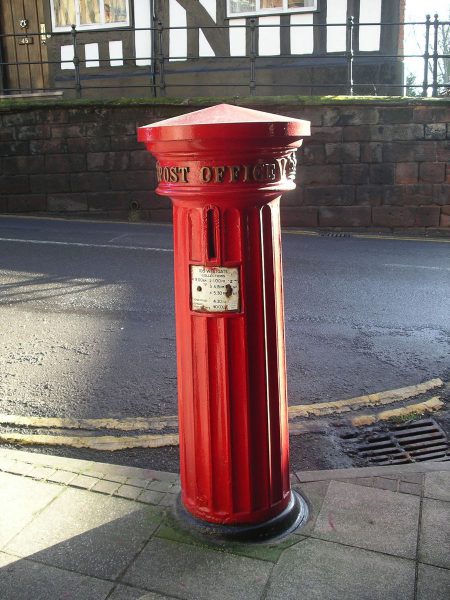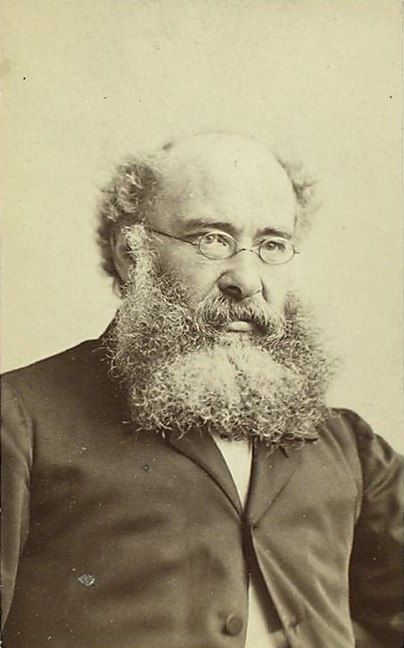
1856 Pillar Box at West Gate, Warwick, Warwickshire, England
On April 24, 1815, English novelist of the Victorian era Anthony Trollope was born. Trollope wrote novels on political, social, and gender issues, and other topical matters. Among his best-known works is a series of novels collectively known as the Chronicles of Barsetshire, which revolves around the imaginary county of Barsetshire. He furthermore introduced the familiar red pillar boxes in Britain as street-side receptacles of letters for collection by the Post Office.
“It would seem that the full meaning of the word marriage can never be known by those who, at their first outspring into life, are surrounded by all that money can give. It requires the single sitting-room, the single fire, the necessary little efforts of self-devotion, the inward declaration that some struggle shall be made for that other one.”
Anthony Trollope, The Bertrams (1859), Ch. 30
Anthony Trollope – Background Information
Anthony Trollope studied at Winchester College and later offered a commission in an Austrian cavalry regiment. In order to start the position, Trollope had to learn French and German and had one year to accomplish this. In order to do so, Trollope started a position as an assistant master in a school in Brussels. However, after a few weeks Trollope was offered the position as clerkship in the General Post Office which he began in 1834. During 1841, Trollope moved to Ireland to take up a position as postal surveyor’s clerk.

Anthony Trollope (1815-1882)
Through the years, Anthony Trollope’s enthusiasm for literature increased and even though he had decided to become a novelist himself, he only managed to accomplish little writing during his first years in Ireland. The Macdermots of Ballycloran became his first novel and was written during the mid-1940s. He managed to write during the trips he took for his postal duties and eventually became a very prolific author. Trollope wrote four novels about Ireland, while two of them were written during the Great Famine.
Reorganizing Rural Mail Delivery
Back in England in 1851, Anthony Trollope started to investigate and reorganize rural mail delivery in south-western England and south Wales. During this mission, Trollope traveled across Great Britain, often on horseback, which also influenced his writing. For instance, Trollope visited Salisbury Cathedral where it is believed he conceived the plot of The Warden.
In 1859, Trollope sought and obtained a position in the Post Office as Surveyor to London’s Eastern District, comprising Essex, Suffolk, Norfolk, Cambridgeshire, Huntingdonshire, and most of Hertfordshire. Next to his advances as an author, Trollope also reached a senior position within the Post Office hierarchy. Anthony Trollope is further credited with the introduction of the pillar box in the United Kingdom.
The Pillar Box
Before the pillar boxes were introduced, it was back then usual to either take outgoing mail to the nearest letter-receiving house or post office, people sometimes took their letters personally to the receiver, or they handed them to a postmaster. Back then, the Secretary of the Post Office Sir Rowland Hill sent Trollope to the Channel Islands to ascertain what could be done about the problem of collecting the mail on a pair of islands. The problems identified in the Channel Islands were caused by the irregular sailing times of the Royal Mail packet boats serving the islands due to weather and tides.
Anthony Trollope then recommended to employ a device he may have seen in use in Paris: a “letter-receiving pillar” out of cast iron and around 1.5m high. According to Trollope’s estimation, four of these pillars were needed for Guernsey and five for Jersey. The first four pillar boxes were erected in David Place, New Street, Cheapside and St Clement’s Road in Saint Helier and brought into public use on 23 November 1852. Even though the new device had obvious drawbacks including the rainwater ingress, they were instantly successful. In the beginning, there was no standard design for the boxes and numerous foundries created different sizes, shapes and colors. In 1857, the first standardization came with deliberations of the Committee for Science & Art of the House of Lords. In 1859, a bronze green colour became standard until 1874. Initially, it was thought that the green colour would be unobtrusive. However, it soon became clear that it was too unobtrusive, since people kept walking into them. Red became the standard colour in 1874, although ten more years elapsed before every box in the UK had been repainted.
Later Years
In 1880, Trollope moved to the village of South Harting in West Sussex. He spent some time in Ireland in the early 1880s researching his last, unfinished, novel, The Landleaguers. It is said that he was extremely distressed by the violence of the Land War. Anthony Trollope died in Marylebone, London in 1882 at age 67. After his death, Trollope’s An Autobiography appeared and was a bestseller in London. Trollope’s downfall in the eyes of the critics stemmed largely from this volume. Even during his writing career, reviewers tended increasingly to shake their heads over his prodigious output, but when Trollope revealed that he strictly adhered to a daily writing quota, and admitted that he wrote for money, he confirmed his critics’ worst fears. Writers were expected to wait for inspiration, not to follow a schedule.
J. Hillis Miller, The Pleasure of That Obstinacy, [4]
References and Further Reading:
- [1] Anthony Trollope at the Victorian Web
- [2] Anthony Trollope Short Biography at Britannica
- [3] Anthony Trollope at Wikidata
- [4] J. Hillis Miller, The Pleasure of That Obstinacy, Frederick Van Dam @ youtube
- [5] Farrugia, Jean Young (1969). The Letter Box: a history of Post Office pillar and wall boxes. Fontwell: Centaur Press.
- [6] Robinson, Martin (2000). Old Letter Boxes. Princes Risborough: Shire Publications.
- [7] Westcott, Kathryn (18 January 2013). “Letter boxes: The red heart of the British streetscape”. BBC.
- [8] Shumaker, Wayne (1954). “The Mixed Mode: Trollope’s Autobiography.” In English Autobiography, Berkeley: University of California Press.
- [9] Garnett, Richard (1899). . In Lee, Sidney (ed.). Dictionary of National Biography. Vol. 57. London: Smith, Elder & Co. pp. 238–242.
- [10] Works by or about Anthony Trollope at Internet Archive
- [11] Timeline for Anthony Trollope, via Wikidata






Pingback: Whewell’s Gazette: Year 3, Vol. #37 | Whewell's Ghost